|
|
|
Published
on 10
Oct 2010
|
All rights reserved.
|
|
|
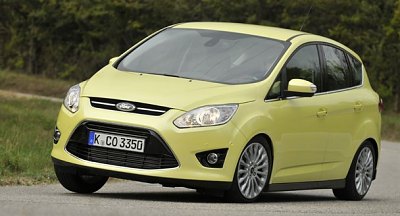
|
Class-leading driving dynamics puts
C-Max to the top of keen driver's choices.
|
Modern
family men want a
car that can carry their wives and kids to picnic at weekends yet
without compromising looks and driving fun that they have to live with
everyday. The first car to satisfy this requirement was the 1997
Renault Scenic, but it was the 2003 Ford Focus C-Max that brought
driving dynamics to a new level, one can truly let the driver enjoy
driving it. Don't know why, European Ford always knows better than most
others how to engage its drivers, no matter from excellent damping,
communicative and well-weighted steering or fine body control. That is
why we rated Mondeo, Focus and Fiesta so high. The new generation C-Max
is the no exception. Drive it over a stretch of back roads and you will
be amazed with its agility and entertaining character. It beats other
small MPVs for driver appeal.
The new C-Max is no longer a family member of Focus but a standalone
model, just like how Scenic departed from Megane a few years ago.
However, that does not mean it was mechanically unrelated to Focus. On
the contrary, C-Max is the first application of the company's new
global C-platform, which will underpin the next generation European and
American Focus, Kuga and "new Capri". Eventually, it will give an
economy of scale of more than 2 million cars a year, so it is the most
important platform to Blue Oval.
The new global C-platform still ride on MacPherson struts up front and
compact "controlled blade" multi-link suspensions at the back. Ride
quality is improved by larger diameter dampers with revised valving. As
expected, more usage of high-strength steel in its monocoque chassis
improves its rigidity to weight ratio. Slightly wider tracks also
benefits handling. The biggest change from the old platform is
steering, switching from electro-hydraulic to pure electrical
assistance. Unlike rivals, Ford waited until this technology matured,
no wonder the C-Max steers with good precision and natural feel.
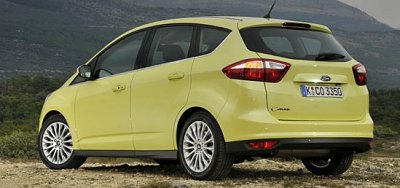 |
C-Max is first application of Ford's
new global C-platform
|
While the old car looked a little
bland - not bad for its time when everybody was experimenting how to
package a large volume smartly - the new car looks far more flowing and
sportier. Ford's new corporate look brings it a prominent trapezoidal
lower grille which looks big enough for the radiator of Evo (half of
the area is actually covered with black plastic). In addition to the
low profile tires and large-diameter turbine blade wheels shown in
these pictures, it appears to be a performance MPV. No, C-Max has no
intention to rival Opel Zafira OPC. There's just not sufficient demand
on the market. What most male customers want is just a sporty
appearance enclosing a sensible / affordable package. In fact, our
reigning champion Honda Stream found the same in the Asian market.
That's why C-Max offers sensible engines. Petrol and diesel sales split
about half-half in Europe, so it offers 2 petrol engines and 2 diesel
engines. The diesel engines are the familiar 1.6TDCi and 2.0TDCi, each
offers two states of tune (95hp or 115hp for 1.6TDCi; 140hp and 163hp
for 2.0TDCi). As we always know, they are highly competitive for
performance, refinement and economy. However, the biggest news should
be the 1.6-liter Ecoboost petrol engine. This is its first appearance
on Ford models. Combining dual-VVT, direct injection and
exhaust-integrated low-inertia turbocharger, it delivers plenty of
low-end grunt (177 lb-ft peaks from 1600-4000 rpm) and 150-smooth
horsepower at the top end. It loses not much fuel economy to the diesel
but compensated with sweet-revving manner and lovely sound. Later on, a
180hp version will be offered as well. 1.6 Ecoboost is definitely the
pick of the range. Finally, at the bottom end there is a 105hp 1.6
Ti-VCT petrol to serve those have limited budget.
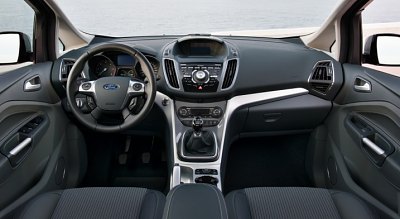
|
As spacious and versatile as you can
dream of... though not as tasteful as French rivals.
|
On the road, the C-Max 1.6 Ecoboost is
the best driving small MPVs we have seen. It feels energetic, competent
and eager to be driven. Body roll is surprisingly limited by the
standard of its class, thanks to the sophisticated suspensions and a
tuning biased to the firm side. Its steering is quick and accurate at
speed yet light at parking speed. Steering feel might be a bit less
intimate than the outgoing electro-hydraulic assisted rack, but still
it loads up linearly and naturally. A firm suspension setting results
in a slightly harsh ride over big bumps in urban area, but as speed
rises its composure approaches perfection. The Ecoboost engine provides
effortless performance and superb refinement. 6-speed manual gearbox is
slick, while the Getrag-built "Powershift" twin-clutch box is even more
satisfying. C-Max never disappoints in driving dynamics and refinement.
Inside, the design theme is again sporty. It is not as tasteful as
French rivals (e.g. Peugeot 3008 and Citroen C4 Picasso), especially
the mix and match between black plastics and fake alloy. Anyway, soft
surface of the dash top and piano-black face of center console deliver
a generally high-quality feel. The C-Max is as spacious and versatile
as you can dream of. The rear bench is 40-20-40 split. The center one
may fold away, allowing the other two slide diagonally inward and
backward to create a super-spacious environment for two big guys.
Luggage space is good with or without the rear seats in place. The rear
seats may fold or tip forward independently to make a large and flat
loading bay. If not enough, you may even remove all the rear seats,
given you have somewhere else to store them.
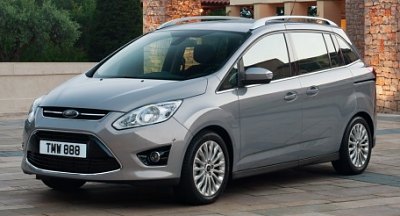
|
Grand C-Max takes on 7-seater rivals
|
Grand
C-Max
In Europe, about half of the small MPV sales go to 7-seaters such as
Opel Zafira, Renault Grand Scenic, Citroen Grand C4 Picasso and the
7-seat version of Volkswagen Touran. Therefore this time around C-Max
also offers a Grand 7-seat version. It gets a wheelbase stretch of 140
mm, a taller roof and an extra 110 kg to accommodate the third row
seats, which are a squeeze for adults and more suitable to children. By
folding away the middle seat of second row, it lets the rearmost
passengers to walk easily to the second row. Moreover, unlike the
5-seater, the Grand C-Max has a pair of large sliding rear doors to
ease access.
The 7-seater will also be available to the US market. Maybe this is the
reason it adopts a softer suspension setting. Predictably, it gives
slightly smoother ride in the expense of a little bit body control. Its
look is a little compromised by the extra length and height, lacking
the sportiness and integrity of the C-Max. Unless you really need to
carry more than 5, the C-Max will be the better buy.
Combining class-leading driving dynamics, excellent engines,
competitive accommodation and versatility, C-Max is the best small MPV
today, and the only one worth a 5-star rating from keen driver's point
of view.
|
Verdict:      |
| Published
on 5
Oct
2012 |
All rights reserved.
|
|
C-Max Hybrid
|
|
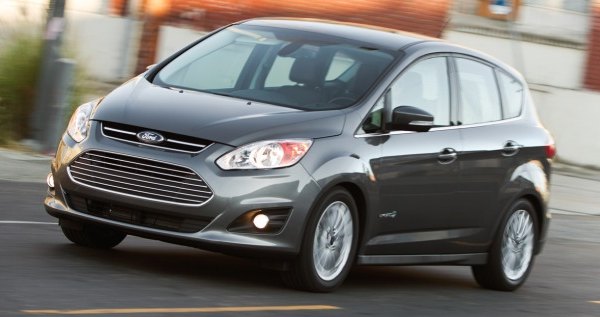
|
The C-Max is our favourite
small people carrier as it combines functionality with good dynamics.
Now it is added with another merit: green. C-Max Hybrid employs the
same powertrain as the new Fusion Hybrid – a 2-liter Aktinson-cycle
engine paired with an electric motor and a planetary CVT. Its maximum
output is 188 hp, 141 of which comes from the gasoline engine. It is
actually the most powerful C-Max on offer. Even though it carries some
160 kg of extra weight, it is capable of accelerating from rest to 60
mph in just over 8 seconds. That is almost 2 seconds quicker than its
only rival in the market, Toyota
Prius V.
The fact that the C-Max Hybrid is marketed as a rival to Prius V is
interesting. Until now the C-Max range is not available to the US
market. Ford plans to sell only the hybrid model there so that it could
be easier to establish a green image like Prius. As its hybrid
powertrain and donor platform (Focus) are already built in the US, the
final assembly of the car takes place in Michigan.
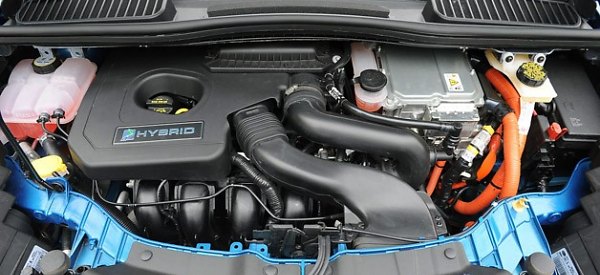
|
Compare with Prius V, the C-Max has a lot of advantages,
such as a more stylish look, higher quality interior, more passenger
space, higher performance and better handling. It even excels in fuel
economy, at least according to EPA figures. It registered 47 mpg for
both highway and city, whereas Prius V managed just 40 mpg highway and
44 mpg city. It can run on purely electricity at a speed up to 62 mph,
versus 25 mph in the case of Toyota. Its Lithium-ion battery occupies
less space than the Toyota's NiMH battery. All in all, the Ford seems
to be superior. The only thing it cannot match its rival is the lack of
7-seat option, as the Hybrid
model is not available with Grand C-Max body.
In actual driving it also works brilliantly. The powertrain integration
is superbly refined so that you can hardly tell whether engine or motor
is providing propulsion. The steering is European weighty and
confidence-inspiring. There is more body motion than the regular C-Max
due to the extra weight, but it is well damped. The chassis feels
solid. The ride is smooth and quiet. The only flaw is a touchy brake
pedal – a common problem of most hybrids. However, given the experience
of Fusion Ford is likely to resolve the problem when the car goes into
mass production. We would still choose the regular C-Max for driving
fun, but as far as a hybrid people carrier is concerned, nothing could
beat the C-Max Hybrid.
|
Verdict:      |
|
|
|
|
|
|
|
|
|
|
C-Max 1.6 Ecoboost
|
2010
|
| Front-engined,
FWD |
| Steel monocoque |
| Mainly steel |
| 4380 / 1828 / 1626 mm |
| 2648 mm |
Inline-4
|
| 1596 cc |
DOHC 16 valves, DVVT
|
| Turbo |
| DI |
150 hp
|
177 lbft (199 lbft overboost)
|
| 6-speed manual |
F: strut
R: multi-link
|
| - |
| 215/55R16 |
1385 kg
|
| 127 mph (c) |
8.8 (c)
|
| - |
|
Grand C-Max 2.0TDCi
|
2010
|
| Front-engined,
FWD |
| Steel monocoque |
| Mainly steel |
| 4520 / 1828 / 1684 mm |
| 2788 mm |
Inline-4, diesel
|
| 1997 cc |
DOHC 16 valves
|
| VTG turbo |
| CDI |
163 hp
|
251 lbft
|
6-speed twin-clutch
|
F: strut
R: multi-link
|
| - |
| 215/55R16 |
1634 kg
|
| 127 mph (c) |
9.2 (c)
|
| - |
|
C-Max Hybrid
|
2012
|
| Front-engined,
FWD |
| Steel monocoque |
| Mainly steel |
| 4409 / 1828 / 1623 mm |
| 2648 mm |
Inline-4, Atkinson cycle, electric
motor
|
| 1999 cc |
DOHC 16 valves, VVT
|
-
|
| - |
Engine: 141 hp
Motor: 118 lbft
Combined: 188 hp
|
Engine: 129 lbft
Motor: 117 lbft
|
| CVT |
F: strut
R: multi-link
|
| - |
| 225/50VR17 |
1636 kg
|
| 115 mph (c) |
7.9*
|
| 21.3* |
|
|
|
|
|
Performance
tested by: *C&D
|
|
|
|
|
|
|
|
|
Copyright©
1997-2012
by Mark Wan @ AutoZine
|
|